Will Pickup Buyers Embrace A Turbocharged V6? They Should, And Fast.
The year is 1977. Jimmy Carter replaces Gerald Ford to become the 39th President of the United States and creates the United States Department of Energy. Apple Computer is incorporated, and the Commodore PET, the world's first personal computer, is sold. NASA's first space shuttle is christened Enterprise and performs its initial test flight.
Music lovers welcome Fleetwood Mac's latest release, the Grammy-winning album Rumours. The Supremes, Elvis Presley and Led Zeppelin play their final concerts, and, later in the year, Elvis leaves the building for good. The top grossing movie? Star Wars. On television, Fonzie rather famously jumps the shark.
In the world of automobiles, Porsche introduces the front-engine 928 and Burt Reynolds turns the black and gold Pontiac Trans-Am into an object of desire. And, finally, the Ford F-Series earns its status as the best-selling vehicle line in America. Clearly, a lot has changed since 1977... except, of course, for the Blue Oval, which can still boast that its full-size pickup truck is the number one nameplate in the United States.
Ford has no intention of passing that particular baton to anyone else, and in order to maintain this impressive bit of marketing gold for a 34th straight year, the Dearborn-based automaker is putting four brand-new engines, including a 3.5-liter turbocharged EcoBoost V6, in the engine bay of its F-150. The automaker says 2011 marks "the most significant powertrain upgrade in 62 years of the F-Series." We, of course, had to verify that claim for ourselves.
Continue reading...
2011 Ford F-150 – Click above for high-res image gallery
The year is 1977. Jimmy Carter replaces Gerald Ford to become the 39th President of the United States and creates the United States Department of Energy. Apple Computer is incorporated, and the Commodore PET, the world's first personal computer, is sold. NASA's first space shuttle is christened Enterprise and performs its initial test flight.
Music lovers welcome Fleetwood Mac's latest release, the Grammy-winning album Rumours. The Supremes, Elvis Presley and Led Zeppelin play their final concerts, and, later in the year, Elvis leaves the building for good. The top grossing movie? Star Wars. On television, Fonzie rather famously jumps the shark.
In the world of automobiles, Porsche introduces the front-engine 928 and Burt Reynolds turns the black and gold Pontiac Trans-Am into an object of desire. And, finally, the Ford F-Series earns its status as the best-selling vehicle line in America. Clearly, a lot has changed since 1977... except, of course, for the Blue Oval, which can still boast that its full-size pickup truck is the number one nameplate in the United States.
Ford has no intention of passing that particular baton to anyone else, and in order to maintain this impressive bit of marketing gold for a 34th straight year, the Dearborn-based automaker is putting four brand-new engines, including a 3.5-liter turbocharged EcoBoost V6, in the engine bay of its F-150. The automaker says 2011 marks "the most significant powertrain upgrade in 62 years of the F-Series." We, of course, had to verify that claim for ourselves.
Continue reading...
Photos copyright ©2010 Jeremy Korzeniewski / AOL and Ford Motor Company
As far as outward appearances go, not much has changed for the 2011 Ford F-150. That's not really a problem in our books, as the 2010 model was nothing if not a handsome pickup truck. Similarly, there wasn't much that needed altering in the overall ride and handling compromise; steering remains very light and a little slow, just as Ford's F-150 has been for years, and it handles... well, like a truck, albeit a fully modern truck with an extremely stiff, fully-boxed frame. No problems there. The only real issue we had with the 2010 F-Series was its aging engine lineup, so we're plenty happy to see that this is where Ford spent all of its engineering resources.
Let's start with the base engine, which quite thankfully puts the old 248-horsepower 4.6-liter, two-valve V8 out to pasture. The new 3.7-liter V6 powerplant may be down two cylinders from the mill it replaces, but it's a much more modern design. Plus, with 302 horsepower and 278 pound-feet of torque, it's also significantly more powerful.
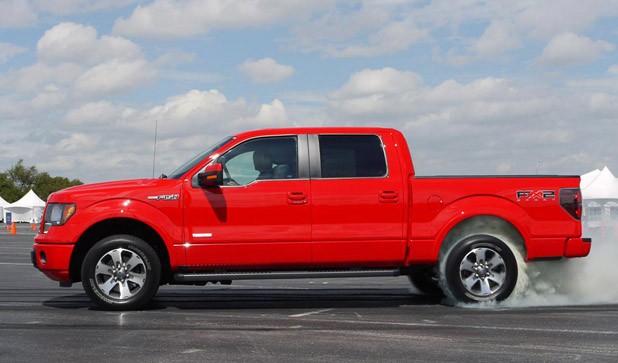
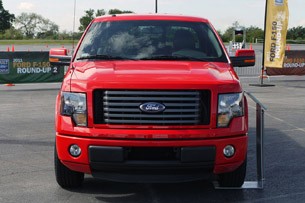
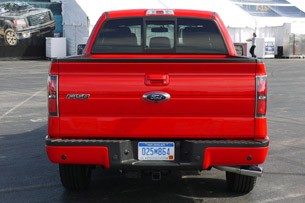
In order to provide a proper frame of reference, Ford brought along a smattering of trucks from its competitors (how thoughtful of them!) including an example of the 2010 Chevrolet Silverado with General Motors' long-running 195-horse 4.3-liter V6. Considering that Ye Olde 4.3-liter has been around practically since the invention of the wheel itself, we weren't surprised when our back-to-back driving loops proved Ford's DOHC V6 absolutely trounces its competitor from The General in every possible category, from smoothness to throttle response to outright power.
What we didn't count on, though, was just how superior Ford's 3.7-liter V6 would feel to GM's 4.8-liter Vortec 4800 V8, which offers up a matching 302 horsepower and, at 305 lb-ft, more torque than the Ford. Our butt-dynos told our brains that Ford's V6 was a superior performer to its biggest competitor's entry V8, and the parking lot drag races that ensued later on in the day (against Chevrolet, Ram and Toyota trucks that were straight from the showroom floor) proved that gut reaction to be absolutely correct. Even more surprising after pouring through the data was that Ford's 3.7-liter V6 actually managed to put down slightly better acceleration runs than GM's even larger 5.3-liter V8! Don't believe us? Click here to check out the data for yourself. Keep in mind, though, that these numbers were generated unladen, and we imagine the superior torque of the competitor V8s would be a boon when towing or with a full bed.
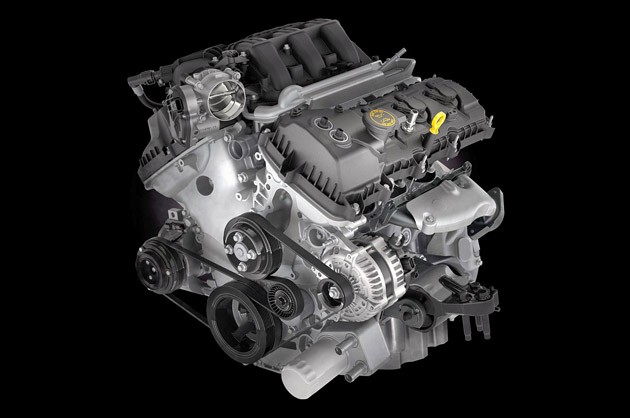
2011 Ford F-150 3.7-liter V6
Enter Ford's new 5.0-liter Coyote V8, as previously seen in the 2011 Mustang GT. Yes, changes have been made for truck duty, namely a somewhat milder camshaft profile and a compression ratio lowered from the Stang's 11.0:1 down to 10.5:1. These changes are intended to move the somewhat peaky Mustang-spec 5.0 V8's horsepower and torque curves further down in the rev range. Judging from the time we spent behind the wheel, the alterations are mostly successful, though power still continues to build in intensity as the tach climbs towards redline in what we'd generally describe as a rather un-trucklike kind of way, though we mean that in the best way possible. Other changes include exhaust manifolds with thicker walls and a new oil cooler in order to stand up to the heat generated by the workload expected from a truck.
Ford expects that the 5.0-liter V8 will be the volume sales leader for the 2011 F-150, and that's almost certain to be the case. Fortunately, buyers ought to be perfectly content with the new mill's 360 horsepower and 380 lb-ft of torque, which is sufficient to allow for a max tow rating of 10,000 pounds. In the view of the Blue Oval Boys, the 5.0-liter V8 faces off against the 4.8-liter Vortec V8 from The General. If that's the case, well, there's no contest. Ford's new engine completely outclasses the 4800. Perhaps a more worthy competitor would be GM's 5.3-liter V8, but even that engine and its 315 ponies can't muster the beans to go toe-to-toe with Ford's five-point-oh. Similarly, the smaller-displacement mills offered in the Ram and Tundra (310 hp, 327 lb-ft) are significantly weaker than Ford's Mustang-derived engine option.
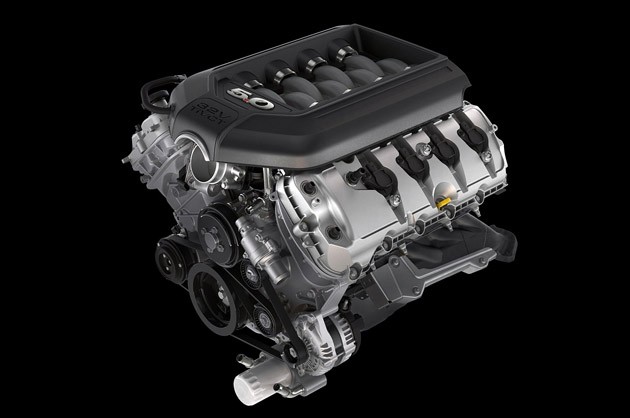
2011 Ford F-150 5.0-liter V8
There are two remaining powerplants to talk about, and though Ford sees its 6.2-liter V8 as the top rung of the F-150 ladder, we're going to go ahead and save the EcoBoost for last. Not that there's anything wrong with Ford's largest-displacement engine option. Far from it, in fact: Nobody is going to scoff at 411 raging horses and 434 lb-ft. of twist. What's more, Yours Truly set the quickest dragstrip time of the entire event – a 7.985-second run at over 68 miles per hour down what was almost-but-not-quite an 8th mile – in a 6.2-powered Harley-Davidson F-150.
No, there's nothing at all wrong with the big 6.2-liter V8 or its 11,300-pound tow rating... except that we'd opt for the EcoBoost every day of the week and twice on Sunday. Why, you ask? Well, there are three major reasons: Power, efficiency and price.
Let's start with power, shall we? While its 365 horsepower and 420 pound-feet of torque may look a bit down on paper when compared to the 6.2-liter V8, real-life scenarios prove that the EcoBoost has got the brawn where it counts most: right in the meat of the power band. Ninety percent of the boosted mill's torque is available from 1,700 rpm through 5,000 rpm, allowing it to match the bigger engine's 11,300-pound tow and 3,060-pound payload ratings.
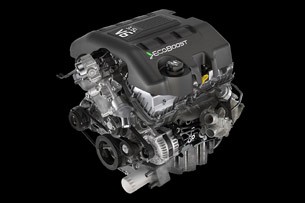
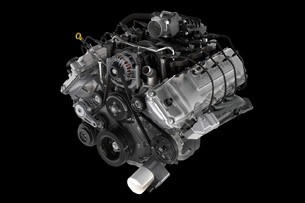
2011 Ford F-150 3.5-liter EcoBoost V6 and 6.2-liter V8
Drag strip testing also fell in favor of the EcoBoost when all the runs were averaged out, and those statistics are right in line with what our seat-of-the-pants impressions told us. And what about efficiency? Ford and the EPA have yet to release official fuel mileage estimates for any of these new powerplants, but you can bet that the EcoBoost will eke out an extra few miles from each gallon of (regular grade) crude pumped into the tank, both when compared to its competitors from other automakers as well as Ford's own 6.2-liter V8.
Which finally brings us to price. Starting with the base 3.7-liter V6, stepping up to a 5.0-liter V8 will run you a reasonable thousand dollars and increase your max tow rating from 6,100 to 10,000 pounds. Moving up to the EcoBoost from the base 3.7-liter V6 will cost $1,750. Believe us when we tell you that you'll consider those 750 dollars over the 5.0 money very well spent every single time you choose to put your foot to the floor. By way of comparison, the top-level 6.2-liter V8 will deplete your checkbook by $2,995 over the base V6. While we're not suggesting it's a bad deal, we are suggesting you save some coin and opt instead for the EcoBoost. Either of the top two engines can tow up to a class-leading 11,300 pounds.
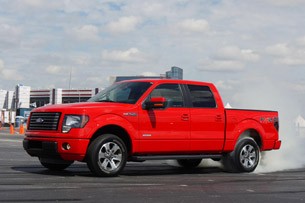
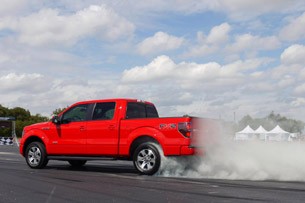
We can't help but wonder how the EcoBoost engine would behave packaged in the almost impossibly off-road capable SVT Raptor, which, like the top-level Harley-Davidson edition for 2011, is only available with the 6.2-liter V8. We suggested to Ford that perhaps an EcoBoost Raptor is something worth looking into, especially considering that the Blue Oval itself has entered a specially prepared truck powered by this exact engine in the grueling Baja 1000. Another strange anomaly that we wished out loud would be rectified was that the base 3.7-liter V6 isn't available with four full doors in SuperCrew trim along with four-wheel drive. It can be had with either one of those configurations (not together), and we're certain there's plenty of power on hand for buyers who only seldom use their truck beds for hauling and want max fuel efficiency the rest of the time.
No matter which engine buyers ultimately choose, they'll be rewarded with a six-speed automatic transmission that was designed by Ford itself, and the automaker is quick to boast that it is the only manufacturer to make six-speeders standard equipment across its entire range of pickups.
That really is a big deal, and here's why: We took the opportunity to compare a 2011 EcoBoost-powered F-150 back-to-back-to-back with competitors from GM and Dodge. We'll be blunt: Chevy's 5.3-liter is completely outclassed in this company. Dodge's Hemi engine, however, felt as if it had plenty of guts to get the job done (390 hp, 407 lb-ft), but part-throttle conditions, such as when maintaining a steady speed up a slight grade or changing lanes to pass slower traffic, caused the Ram's five-speed automatic to drop down a gear (and sometimes even two) when the EcoBoost and its six-speed would resolutely remain in its current ratio and pick up the called-upon speed. That's the result of abundant torque. When we pressed further (not that it was necessarily needed), Ford's tranny would indeed downshift and summon plenty of reserve turbo-fed horses. Impressive power, and also a boon for fuel mileage. Toyota's 5.7-liter V8 (381 hp, 401 lb-ft) also fails to match the barrel-chested feeling of steady-stream torque experienced with the EcoBoost when towing.
Another feature we appreciated is Ford's SelectShift function. While most automakers provide some sort of manual control over the automatic transmission, we applaud Ford for allowing the driver to keep the transmission in a particular gear, even when bumping against redline. Automakers, take note: This is how manual control of automatic gearboxes should always be done.
Of course, four brand-spankin'-new powerplants are the main focus of our attention, but Ford has added a few more meaningful updates for 2011. One highlight is a new LCD productivity screen (previously seen on the latest Super Duty) that puts a 4.2-inch, 480x272-pixel display front-and-center between the two large gauges in the instrument cluster. Tons of useful information is displayed, including current and average fuel economy with range-to-empty, transmission temperature, tire pressure and dual trip odometers. Further, off-roaders can see the lateral, vertical and turning radius dimensions of their maneuvers and those towing a trailer can customize their trailer brakes and even save settings for specific trailers.
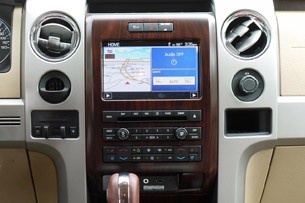
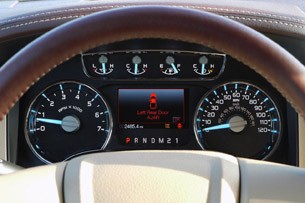
Also available is a SYNC technology package, which includes the Traffic, Directions and Information application that provides hands-free access to personalized traffic reports, turn-by-turn driving directions and information like business listings, news, sports and weather.
To say we were impressed by Ford's latest pickup powertrain packages would be an understatement. We are particularly keen on two of them: the base 3.7-liter V6 and the uplevel 3.5-liter EcoBoost V6. It's truly an excellent sign that even the least expensive and most fuel efficient of all Ford F-Series trucks will boast 302 horsepower – plenty for basic chores and around-town running. Those feeling the need for speed can step up to the turbo mill on a full 90 percent of all F-150 models (including the lower-end XL and XLT) for just $1,750. We see that as a (tire) smoking deal.
As of today, Ford officially offers the very best range of powertrain packages in the half-ton pickup truck marketplace. The only question is... how long will it take for the others to catch up?
Photos copyright ©2010 Jeremy Korzeniewski / AOL and Ford Motor Company
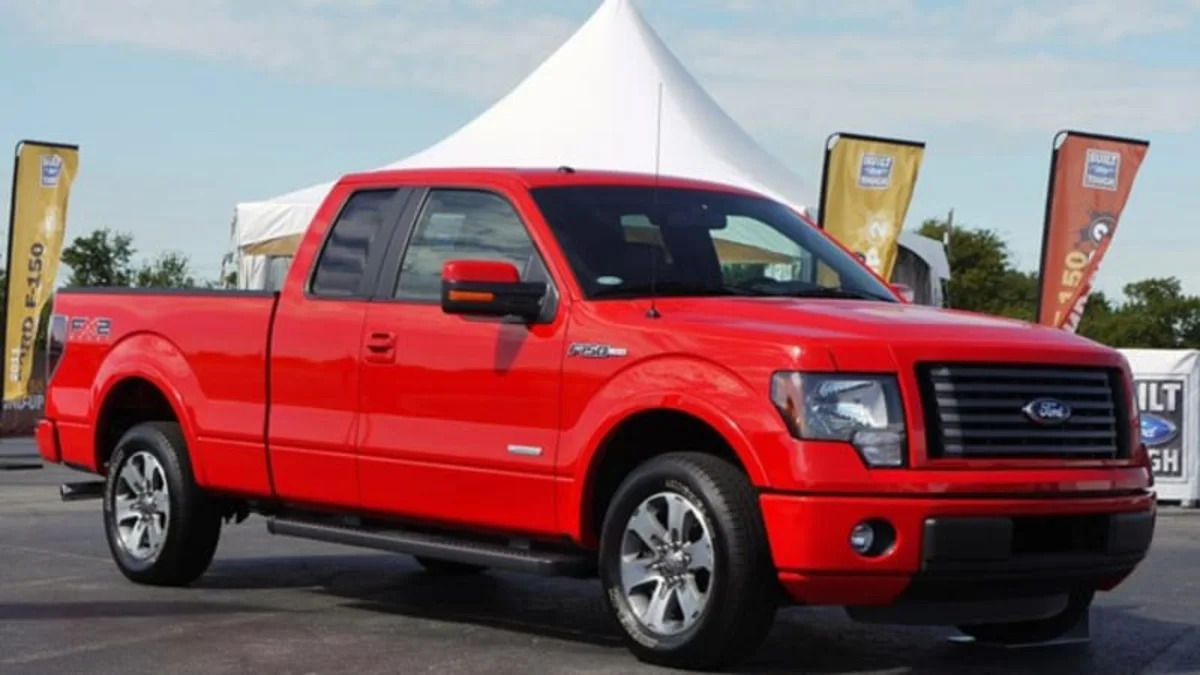
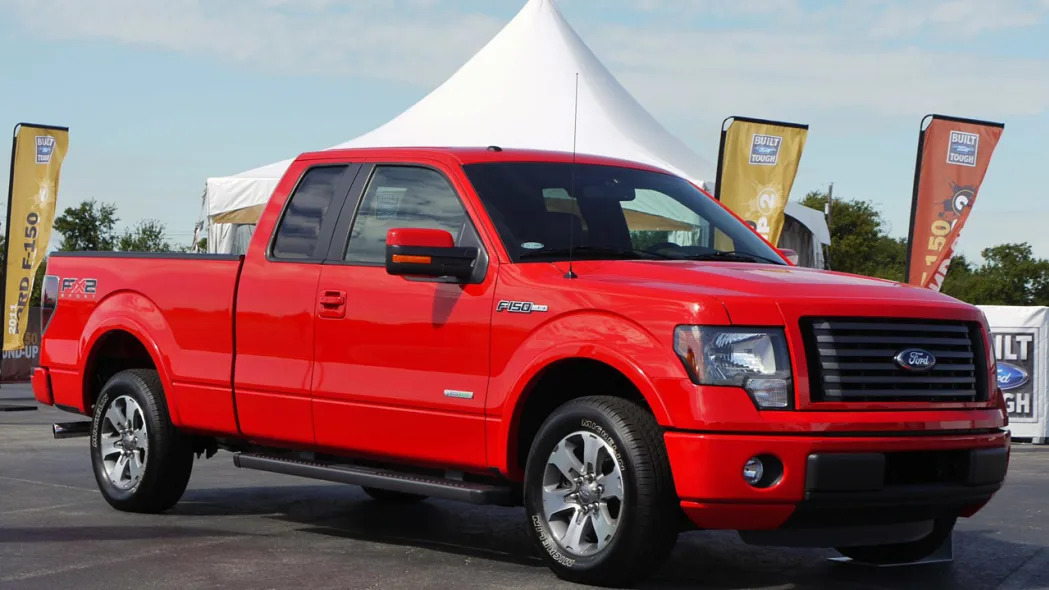
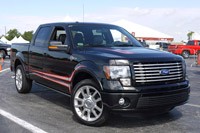
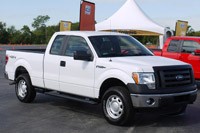
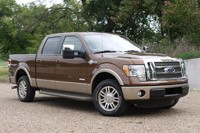

Sign in to post
Please sign in to leave a comment.
Continue